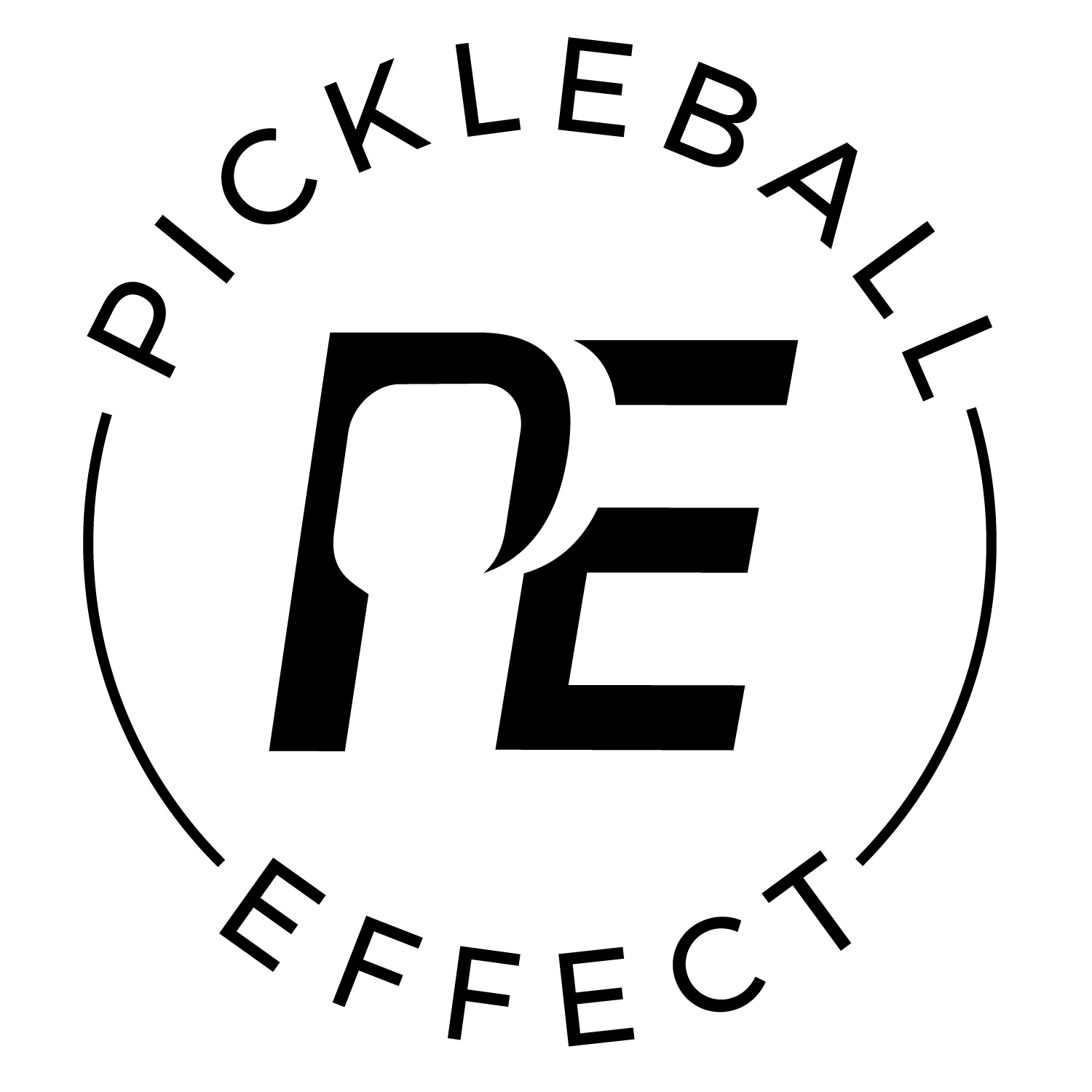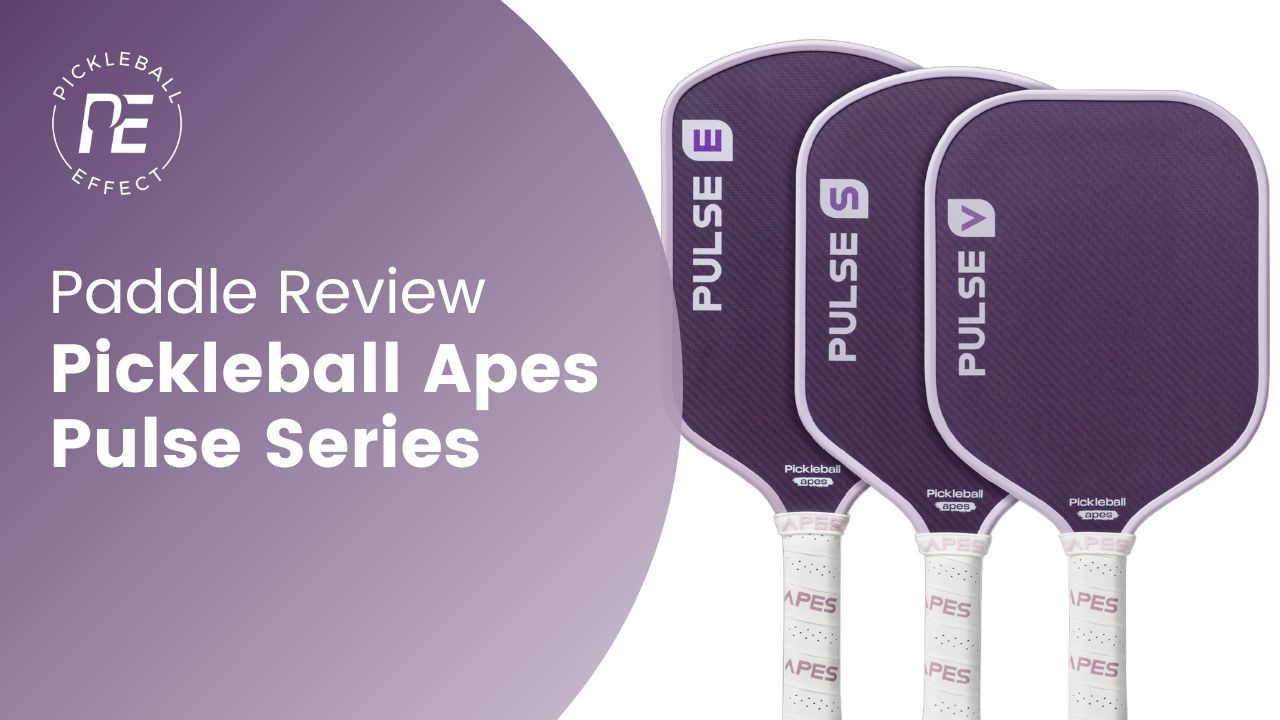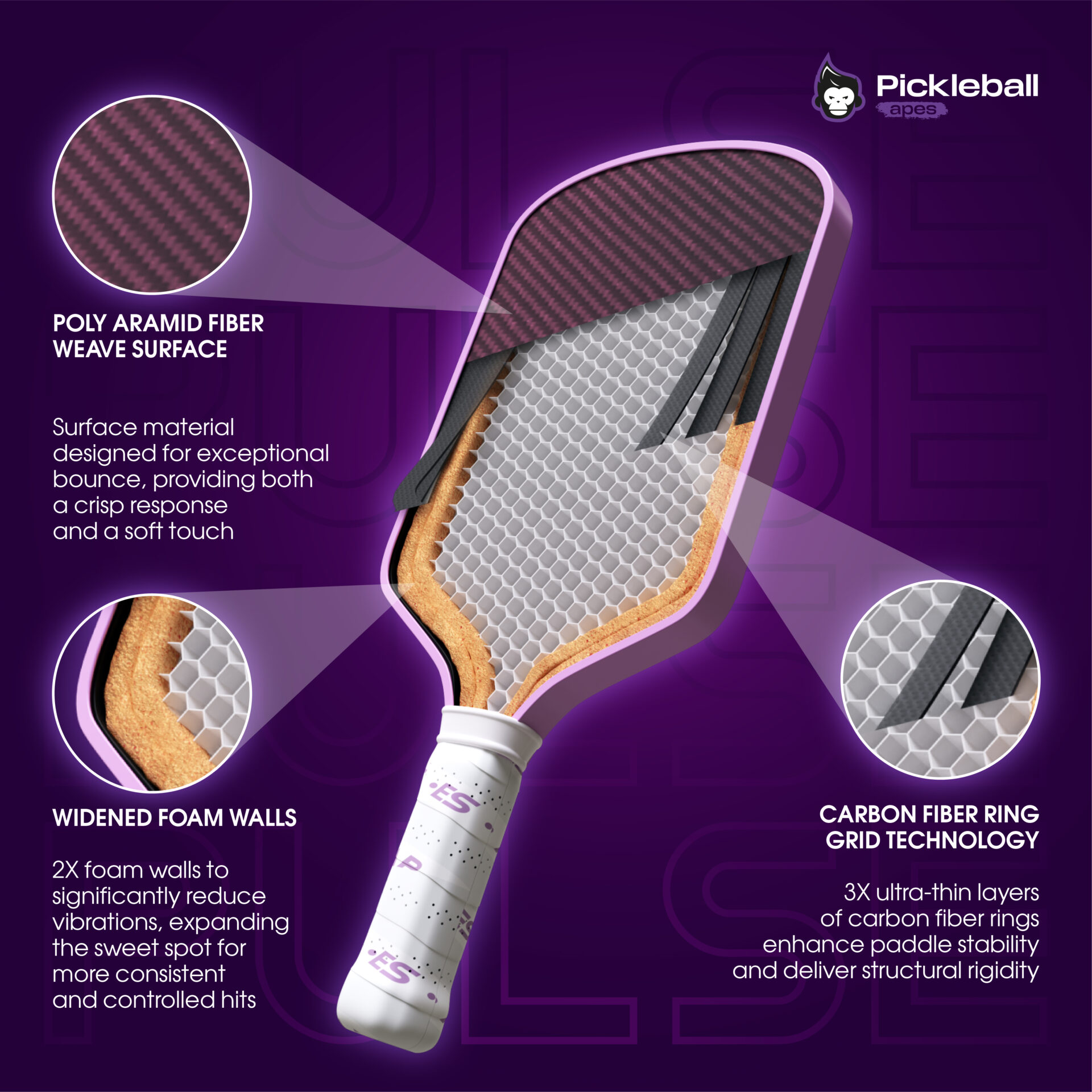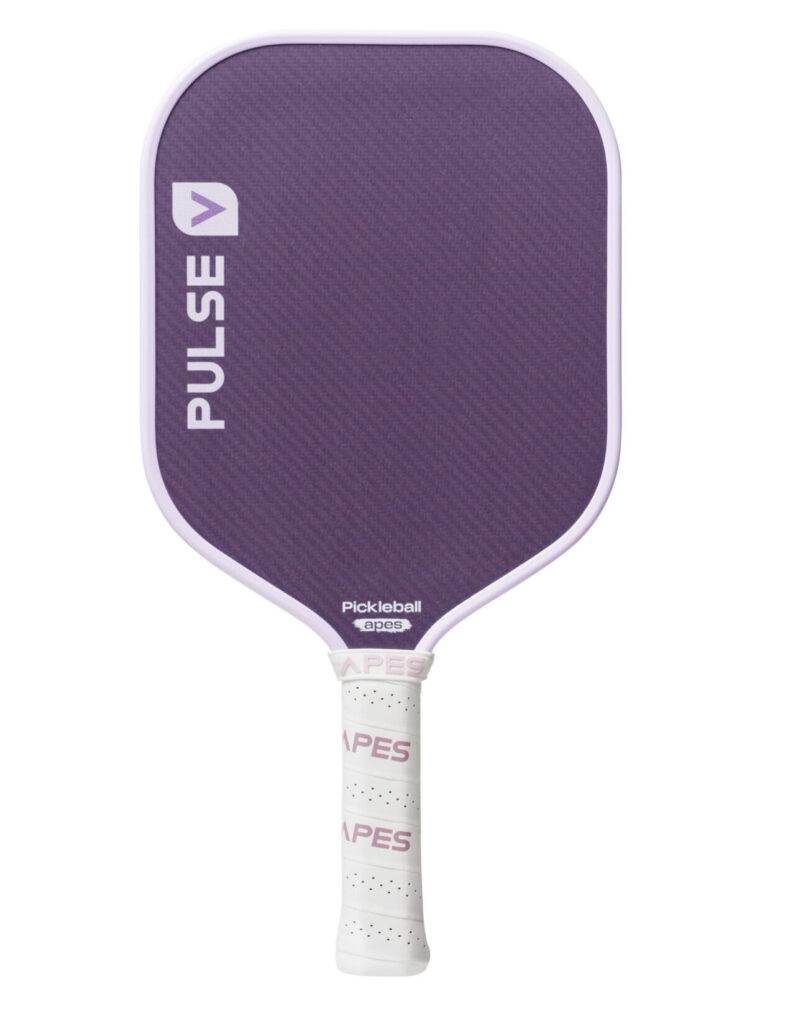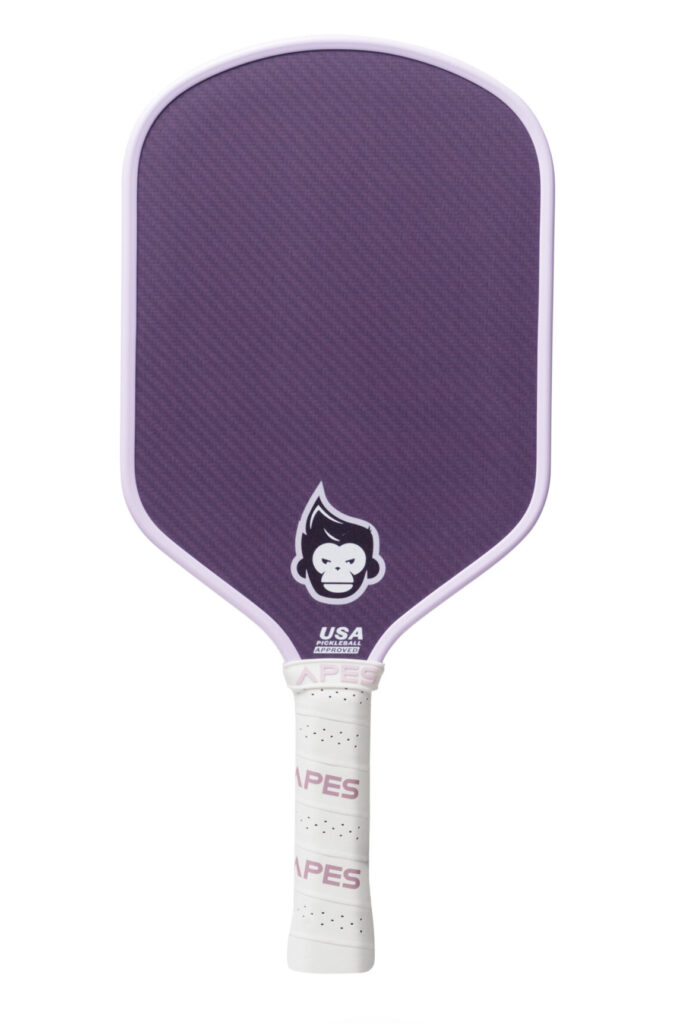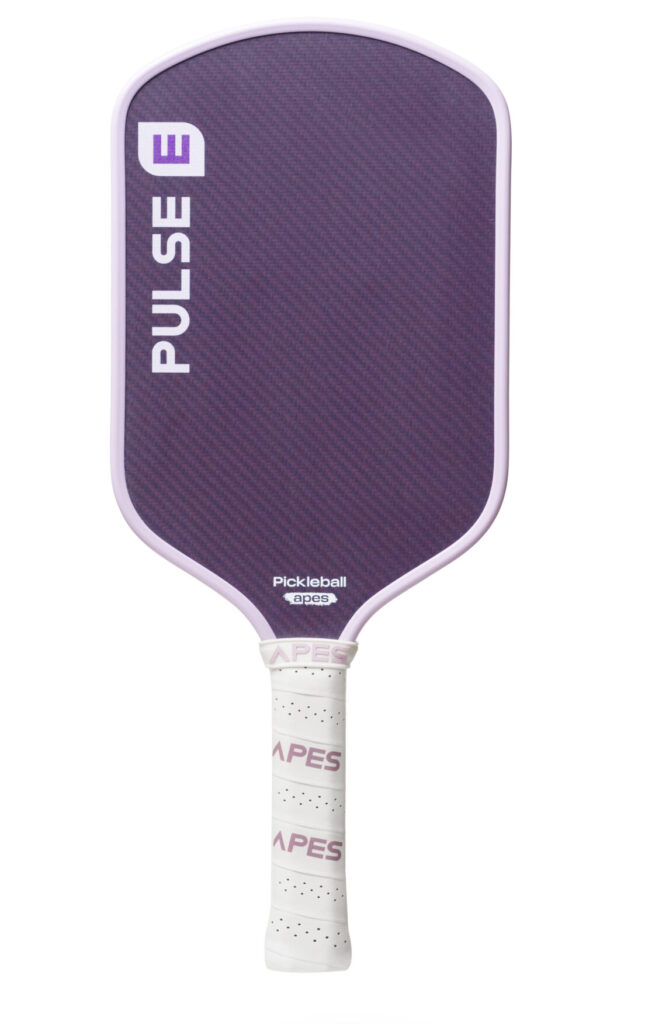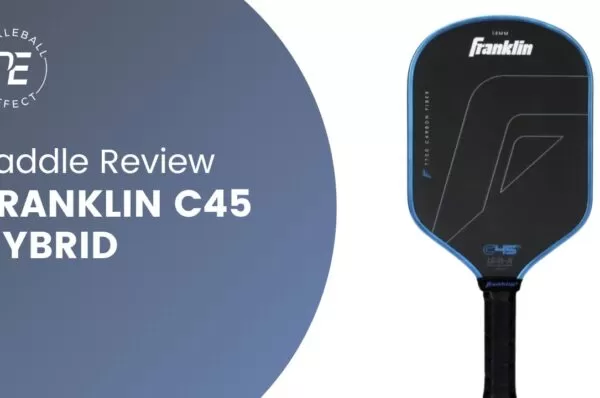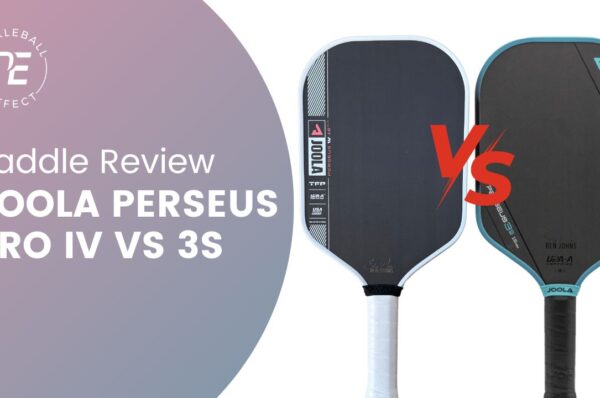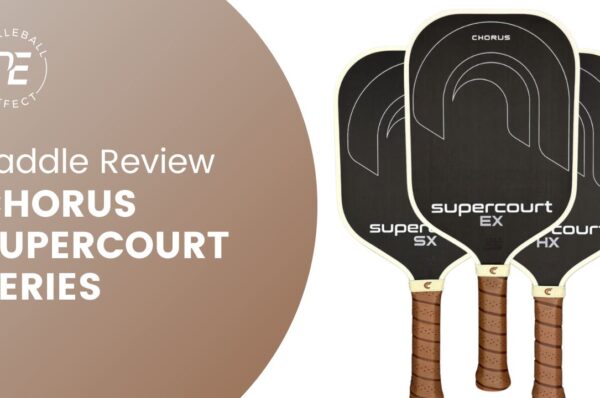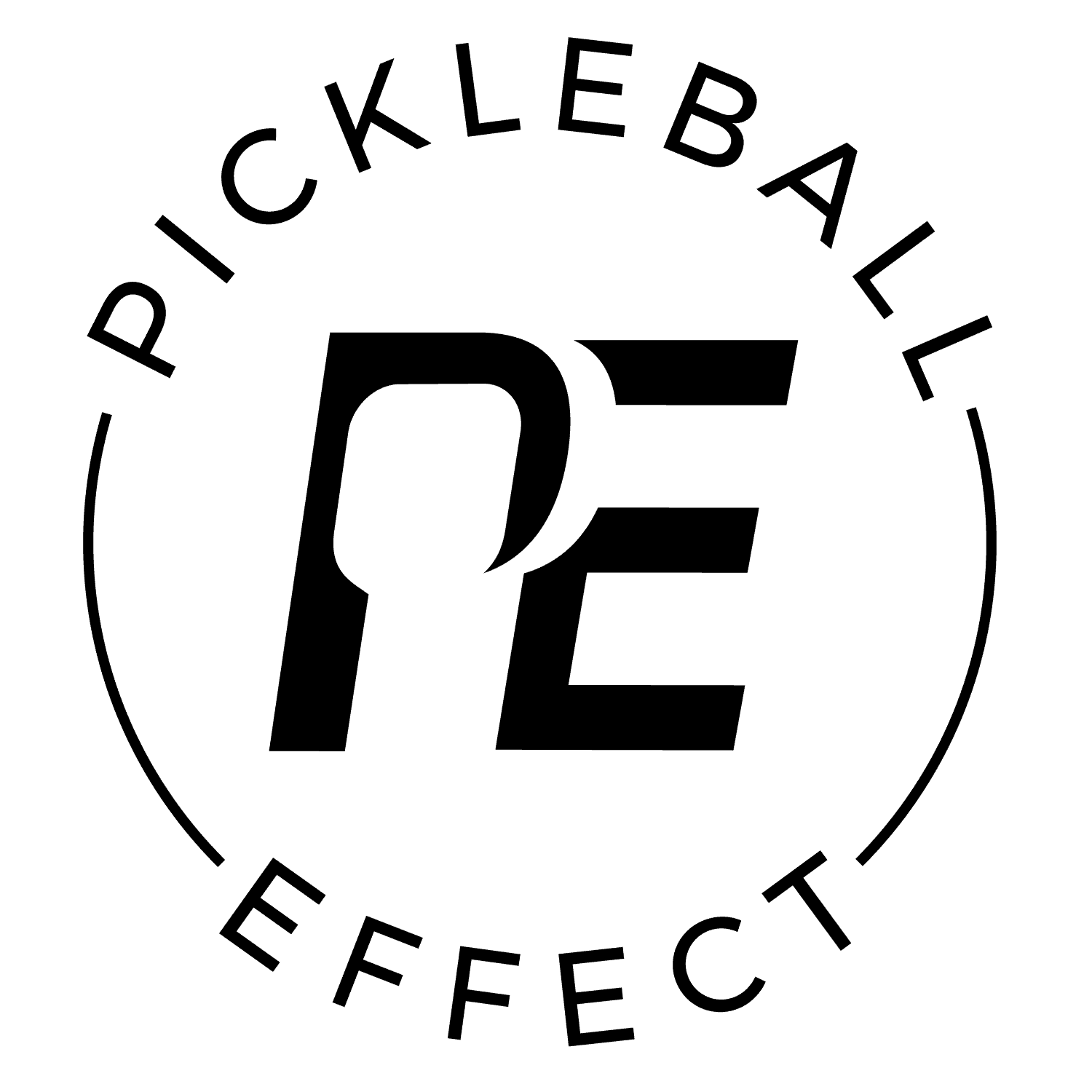Pickleball Apes made their mark in late 2023 when they were the first to introduce Kevlar as a facing surface. If you’ve been following pickleball gear since then, you’ll know that Kevlar has been adopted by the majority of brands. Now, they are launching a new line called the Pulse series. With this new line, they are introducing innovative technology and announced another shape to their lineup, bringing the total to three shapes in the series.
The Pulse series flirts with the control/all court categories, which I think is excellent. While many brands are concentrated on power, no one has invested much R&D into improving control paddles. Instead, older technology has become the default for control paddles because they don’t produce as much power.
In this review, I’ll delve into their technology, provide a performance overview of the series, explain how it differs from past-generation control paddles and why I like this control series is good for intermediate to advanced players.
Table of Contents
Pickleball Apes Pulse Series Technology
As illustrated in the image above, they widened the foam around the edges and then added three carbon fiber rings on top of the foam. We’ve seen widened foam around the edges with the JOOLA 3S series, which resulted in more power, but Pickleball Apes added the foam around the entire paddle and into the handle and didn’t just widen it in the top half like JOOLA did. This configuration resulted in a more control style paddle with reduced vibrations rather than adding more power like the JOOLA 3S paddles.
The carbon fiber rings were then added overtop the foam for extra support and rigidity to help prevent the “break in” period that paddles with more foam incorporated in the core are known for. This way the paddle stays a control style paddle and doesn’t get significantly hotter overtime. More on this below, because there is some nuance to this.
For me this tech does a few things that I like. One, it gives the paddles a dense feel reminiscent of Gen 1 style control paddles, yet a crisper response than those Gen 1 style paddles so that it isn’t overly soft and offers more feedback. Gen 1 style paddles don’t have any foam around the perimeter and are not thermoformed. Two, although the paddles are control oriented, they aren’t the weakest hitting control paddles you’ll find. They are flirting with the all-court line. They give you more offense from drives to counters to meet the modern demands of the game while still enhancing your soft game. And three, the feel of the paddles are comfortable and don’t scream at you on mishits. I think there are many benefits to this new technology, but it doesn’t come without some drawbacks and there are some differences in playability across the three shapes. So let’s dive into that.
Pulse Series Performance Review Summary
I’m going to offer a summary of how the series performs as a whole here and then will dive into some of the differences between the paddle shapes in the shorter individual reviews below.
Control: Here’s what I like most about these paddles. They absorb some pace off the ball for you but still have a crisper response off the face. This way they maintain a generally softer feel at impact, providing the comfortable sensation you want from a control paddle, but offer more feedback than your typical Gen 1 style control paddle. By feedback I mean that a drive has a little different impact feel than what a dink feels like. This feedback in feel is a good thing. It’s information that your muscles and body can use to fine tune the control of the paddle. When you hit a good third shot drop or a high one, they will feel a little different and your body will be able to adjust based on the feedback it’s getting. A Gen 1 style paddle can feel overly soft where a drive and dink feel so similar that it’s more difficult for your body to adjust and fine tune your touch. Then a Gen 2 style paddle that is thermoformed without the widened foam walls feels a little stiffer and offers less shot feedback as well.
The paddles have a medium pop rating, from my tests they came in around the 50-60th percentiles for pop. This is higher than most control paddles and means you have to have some sense of your own touch to control them well though you don’t need to be a 5.0 player to control them or anything. Ultimately, in the short term, it may take you a little longer to dial these in due to the slight extra pop and offense they offer compared to a pure control paddle that absorbs more pace. However, in the long run, I believe most intermediate to advanced level players would be better able to control these due to the additional feedback they provide.
If you’re a lower intermediate to beginner, I don’t think the nuances of the feedback will be beneficial to you yet. There’s no need to spend this much money on a control-style paddle when you can get a quality, plush control paddle like the Vatic Pro Prism Flash for $100. It absorbs more pace off the ball to help you better control the pace of play and reduce pop-ups.
Power & Pop: My paddle tests put the V & S around the 35th percentile in my paddle database for power and the 50th-60th percentile for pop, while the E had a little more power and less pop. From playing, I would have guessed that the power level was a little higher and the pop level a little lower, but those are the numbers I got. I think these offer more offense than your typical control paddles, but you still have to put in the work to get some power and pop out of them. The spin and control are there, so placement and angles came easier and helped win points and apply pressure that way, while still responding decently on put-aways and when your opponents were back. I was playing with the V while also switching between and hitting with the Volair Mach 2 Forza 16 (a pure widebody-shaped control paddle) and the Paddletek Bantam ESQ-C 14.3 (an all-court standard-shaped paddle). The V’s power and pop felt to be in between these two and closer to the Mach 2 Forza 16 than the ESQ-C.
Forgiveness & Maneuverability: The V & S play forgivingly and have lighter swingweights, making them more maneuverable and easier to manage. Both shapes have swingweights between 110-115, which seems to be the sweet spot for most people. The E is more niche with its extra elongated shape, playing with below-average forgiveness and being slower and more cumbersome to maneuver.
Individual Pulse Paddle Reviews
The series comprises three shapes. While each shape maintains the general attributes mentioned above about the series as a whole, there is some nuance to how each shape plays. This section gives an overview of those nuances to help you pick the right shape for you. I love that Pickleball Apes is offering these in three shapes. It’s nice having options to find the paddle that best fits your needs. I’ll start with the shorter and wider V shape and work my way to the longer and skinnier E shape.
Pulse V Review
- Static Weight: 8.2 oz avg
- Swingweight: 110-112 (low)
- Twistweight: 7.4 (very high)
- Spin RPMs: 1978 (high)
- Length x Width: 16″ x 8″ (standard)
- Face: Aramid/Nylon
- Grip Circumference: 4.25″
- Handle Length: 5.5″
- Core: 16.5mm narrow cell poly honeycomb
- Special Features: Thermoformed, double edge foam, carbon ring
- Paddle Type: Aggressive Control
- Price: $199.99 ($180 with code 10EFFECT)
- Warranty: 30 day return demo policy & 1 year warranty – learn more
(Get 10% off with the discount code 10EFFECT from Pickleball Apes website)
This was my personal favorite of the three. It’s a standard shaped paddle paired with a longer handle which has been a popular trend this year. It has a light swingweight of 112 but it’s still enough to plow through the ball without getting pushed around. Then it has a massive twistweight measurement of 7.4 which is as high as any paddle I’ve measured and it plays very forgivingly like the twistweight suggests. Control style paddles in a standard shape can often get too soft feeling and this one doesn’t and exhibits the feel I explained above where it’s a dense, crisp feel. Making it a more responsive feeling and gives you that feedback to fine tune and connect with it well. It had the lowest power and pop ratings of the group, which is to be expected with this shape.
Pulse S Review
- Static Weight: 8.2 oz avg
- Swingweight: 114-116 (low)
- Twistweight: 6.3 (moderate)
- Spin RPMs: 1971 (high)
- Length x Width: 16.4″ x 7.6″ (hybrid)
- Face: Aramid/Nylon
- Grip Circumference: 4.25″
- Handle Length: 5.5″
- Core: 16.5mm narrow cell poly honeycomb
- Special Features: Thermoformed, double edge foam, carbon ring
- Paddle Type: Aggressive Control
- Price: $199.99 ($180 with code 10EFFECT)
- Warranty: 30 day return demo policy & 1 year warranty – learn more
(Get 10% off with the discount code 10EFFECT on Pickleball Apes’ website)
Hybrid paddles surged in popularity last year and into this year, so I’m glad they offer one in the series. It has the characteristics that make this shape so popular. It’s semi-elongated for extra reach without giving up too much forgiveness, and the swingweight stays lower and more manageable than true elongated paddles. The swingweight for my unit was 114, and the twistweight was 6.24. This is a midweight paddle with a slightly above-average sweet spot. I would have guessed the twistweight measurement was higher than what it is based on how it plays, and I think it’s on par with other hybrid paddles, though it’s not any better either. The extra reach and higher swingweight give it a touch more power from the baseline, but the pop remains very close to the V. The feel is slightly stiffer, though not a huge difference from the V. If you want a little extra reach, then I prefer this one over the E model.
Pulse E Review
- Static Weight: 8.2 oz avg
- Swingweight: 125-127 (very high)
- Twistweight: 5.9 (low)
- Spin RPMs: 1971 (high)
- Length x Width: 17″ x 7″ (extra-elongated)
- Face: Aramid/Nylon
- Grip Circumference: 4.25″
- Handle Length: 5.5″
- Core: 16.5mm narrow cell poly honeycomb
- Special Features: Thermoformed, double edge foam, carbon ring
- Paddle Type: Aggressive Control
- Price: $199.99 ($180 with code 10EFFECT)
- Warranty: 30 day return demo policy & 1 year warranty – learn more
(Get 10% off with the discount code 10EFFECT on Pickleball Apes’ website)
This paddle shape is what I call extra-elongated at 17” long. Then it’s paired with an extra-long 6.25” handle. Seventeen inches is the maximum allowed length by USAP paddle regulations. You hardly see any paddles at this length because the longer the paddle, the more head-heavy it tends to get. We see that here with this paddle with its 127 swingweight, which is in the 97th percentile in my paddle database. It feels sluggish when you’re at the net and it’s tough to whip around the body when switching from a backhand to a forehand in fast hand exchanges. But the extra length and swingweight is great from the backcourt on drives and serves. The paddle plows through the ball really well, reminiscent of a tennis racket. It surprises you how much power you get sometimes when you connect just right. And then it feels sturdy and strong at the net when dinking and resetting the ball. This shape actually has less pop than the other two so it was easier to control in some ways.
The extra length is a bit awkward at first and doesn’t feel normal, I kept hitting the ball too low on the face. You adjust overtime but I never completely got used to it.
While playing with the paddle was fun and different. I felt like the benefits you got from the back court with the extra length and swingweight plus the extra reach in general didn’t outweigh the losses in hand speed and lower forgiveness vs the other two shapes. However, I can see this shape being the right option for some niche scenarios. If you have less mobility and need a paddle that gives you maximum reach to cover the court then this is a good option. Also, if you have a strong tennis background and wish the paddles move and felt balanced more similarly to a tennis racket then this is a good option and will feel comfortable and natural to you. Other than that I think there are more drawbacks than benefits to this extra-elongated shape.
Other Considerations & Do These Paddles “Break In”
I want to point out that my good friend and fellow paddle reviewer, John Kew, had a different experience with these paddles than I did. He describes them as being an all-court to power-type paddle. We don’t typically vary this much on our opinions and experiences with paddles like this. I don’t doubt his experience because a few other reviews I’ve read are a bit varied too. Some share many similarities to my experience while others align with John’s. This makes me think there is some variability in how these paddles perform, which could be due to the foam around the edges. Paddles that incorporate foam seem to have more variability than those without heavy use of foam. John and I described the feel of the paddles very similarly, though the power and pop outputs we experienced were different. So if you decide to pick one up, the paddle may be more of an all-court style depending on what you get.
Do these have a break-in period? For this review, I played and drilled with them for about five hours and was switching between the shapes and other paddles I was comparing them to, so I didn’t put enough time on a single paddle shape that would “break it in.” A break-in period means the paddle would change performance and gain a little more power and pop over time after the foam and other materials in the core loosen up. Pickleball Apes claims that the carbon fiber rings on top of the foam help reduce or stop this break-in experience. Pickleball Apes did run tests with a machine to put their paddles through durability testing to back up this claim. You can watch their video about it here. However, there have been several reports from players saying they did experience a break-in period where the paddles got a little juicier over time, though nothing too dramatic. Still, I think it’s something to consider and be aware when thinking about purchasing one of these paddles.
*I’m going to give one of these paddles to a friend to put more time onto it and will update this article here if I experience a break in period with it.
My Recommendation
I think these add a nice, new, modern flavor to control style paddles. When I’m thinking about the future of paddle categories I imagine more and more control style paddles will play like these with a little more feedback, offense and reduced vibrations compared to past generation control paddles. If you’re an intermediate to advanced level player that prefers control style paddles then I think this a better option than past gen control paddles. If you’re a beginner then you would probably still benefit more from a pure control style paddle that you can pick up at a much cheaper price like the Vatic Pro Prism series.
(Get 10% off with the discount code 10EFFECT on Pickleball Apes’ website)
Braydon competes at the 5.0 level and plays in 5-10 tournaments a year. He plays/drills 3 to 4 times a week and would play more if time allowed it.

Paddle Terms Glossary
We’ve categorized paddles into three categories. Control, All-Court, and Power. Paddle categories are determined by Braydon after he hits or reviews the paddle.
- Control paddles offer a softer feel and better absorbs pace off the ball but doesn’t give you as much power.
- All-Court paddles give you a blend of power and control and does well at everything though it doesn’t excel at anything.
- Power paddles often have a firmer feel and will return more power but are harder to control.
A paddle’s weight represents the inherent mass of the paddle as measured on a scale. However, relying solely on this static weight measurement can be misleading when assessing the true perceived heaviness of the paddle. Even if two paddles both clock in at 8 oz, their actual heft in your hand can markedly differ due to variations in weight distribution within the paddle. This is why the static weight should be considered with the swingweight of the paddle. See the definition of swingweight below.
The weight value listed in the database corresponds to the paddle’s weight that I used to gather the swingweight and twistweight measurement. It’s possible that if your paddle has a different static weight than then the swingweight and twistweight may be slightly different.
There are three primary shapes a paddle can have which consists of the length and width of the paddle. These three shapes are:
- Elongated: The dimensions for an elongated paddle are 16.5″ x 7.5″.
- Standard: A standard shaped paddle has dimensions of 16″ x 8″.
- Hybrid: A hybrid shaped paddle falls somewhere in between the standard and elongated shapes, with approximate dimensions of 16.25″ x 7.5″-7.7″.
Then there are two less common shapes you’ll see. These are:
- Extra-Elongated: This shape is 17″ x 7″
- Widebody: This any paddle shorter than 16″ long.
When considering the advantages and trade-offs of paddle shapes, it’s important to understand the characteristics of each shape.
- Elongated Paddle: An elongated paddle offers increased reach, spin, and power. However, this additional reach comes at the expense of forgiveness, particularly from side-to-side.
- Standard Paddle: In contrast, a standard-shaped paddle provides less reach and a little less power & spin but offers greater overall forgiveness. This means that while you may not have the same extended reach as an elongated paddle, you gain better control and stability.
- Hybrid Paddle: The hybrid shape serves as a middle ground between the elongated and standard shapes. It provides a balance between reach and forgiveness, offering players a versatile option that combines aspects of both shapes.
It’s interesting to note that advanced players often prefer elongated shapes. On the other hand, players at lower skill levels typically opt for the extra forgiveness offered by standard shaped paddles.
Ultimately, the choice of paddle shape depends on an individual’s playing style, preferences, and skill level. Whether your focus is on reach or forgiveness, understanding the unique benefits and trade-offs of each shape can assist you in selecting the paddle that best suits your game.
Swingweight is a measure of the paddle’s resistance to swinging about the end of the handle. The higher the swingweight number the heavier it will feel in your hands. A higher swingweight has more power but is harder to swing, lower swingweight is easier to swing but has less power. Sometimes a faster swing with a lower swingweight can make up for power lost in swingweight. The price paid for that is greater impact shock. Stock swingweights will vary between 100 – 140.
Twistweight is the resistance to rotating around the long axis through the middle of the paddle from butt to tip. The higher the twistweight the more resistance the paddle has to rotating on off center hits. This measurement is closely related to the amount of forgiveness or the size of the sweet spot of the paddle. A higher twistweight indicates a bigger sweet spot. Twistweight numbers range from 5 – 8.
Measuring the revolutions per minute (RPMs) off of a serve you get a number that shows the spin potential of a paddle. Using these RPM measurements I’ve created five buckets that a paddle will fall into indicating its overall spin potential. The five buckets are:
1900 or Higher = Very High
1700 – 1900 = High
1500 – 1700 = Medium
1300 – 1500 = Low
1300 or less = Very Low
You can tell a big difference in the amount of spin a paddle generates when you compare a Very High paddle to a low paddle. But the gains from Medium to High to Very High are marginal. We’ve found that having at least a medium rating is often enough if you’re looking for a good spin paddle. However, if you’re a big hitter then you will benefit more from a high spin paddle to help you keep the ball in play more often.
The power level of a paddle is shown in miles per hour (MPH) after taking ten measurements with a speed gun of hitting a serve as hard as I can. This measurement gives you an idea of how hard you can hit the ball when given the chance to take a full swing. So shots like serves, drives and overheads. The higher the MPH reading the more power you can generate with the paddle.
I also show the percentile ranking of the measurement to give you an idea of how it stacks up against the rest of the paddles in my database.
The pop level of a paddle is shown in miles per hour (MPH) after taking the average of ten speed gun measurements of hitting a punch volley as hard as I can. This measurement gives you an idea of how hard you can hit the ball on shorter swings and gives you an idea of how quickly a ball comes off the face when you apply less force on the ball. So shots volleys, dinks, counters, and resets are all affected by the pop measurement. The higher the pop measurement the stronger your counters will be but it takes more skill to keep the ball from floating or popping up on you when resetting a hard hit ball or when dinking.
I also show the percentile ranking of the measurement to give you an idea of how it stacks up against the rest of the paddles in my database.
The term “forgiveness” pertains to both the size of the sweet spot and the stability of the paddle. A paddle that is more forgiving offers a larger sweet spot, greater stability, and yields more power when hitting off-center shots. On the other hand, a less forgiving paddle has a smaller sweet spot and does not provide as much power when hitting off-center shots.
While there seems to be only benefits of more forgiving paddles, less forgiving paddles are often more maneuverable and is easier to generate more paddle speed.
